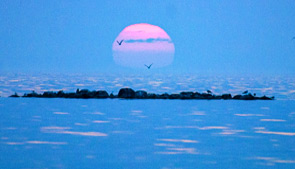On the Latvian coast of the Baltic Sea, two protected habitats of European Union importance - Sand Banks in the Sea and Stonebanks in the Sea. The project aims to clarify their distribution and assess the ecological status of Latvia's exclusive economic zone, according to the most recent findings.
Habitats 1170 stone banks in the sea are one of the most important and ecological types of habitats in the eastern Baltic Sea that have suffered substrate areas (stones, boulders, pebbles) with sand patches. . This habitat type is inhabited by countless species of invertebrates, fish, birds and plants.
Habitats 1110 Sand banks at sea are terrain of elongated, round or irregular shape, permanently covered by sea water. . This habitat consists mainly of sand containing gravel, pebbles, stones and sludge inhabited by the community of bacteria, multi-worms, molluscs and crustaceans s. Sandbanks are important spawning and feeding sites, and they also attract wintering waterbirds.
Exploration of marine protected habitats and determination of the necessary conservation status in the exclusive economic zone of Latvia
Research of marine protected habitats in the EEA and determination of the necessary conservation status in Latvia
European Union LIFE Environment Programme project LIFE19 NAT/LV/000973
» AREAS
Nature protection, preservation of biodiversity, information to the public.
» PROJECT TARGETS
The main objective of the project is the exploration of marine habitats and species and the establishment of a comprehensive protection system for protected marine areas in the exclusive economic zone of Latvia.
The project will carry out mapping and exploration of the dedicated marine habitats of European Union importance 1110 sand banks at sea and 1170 stone banks at sea in an area of approximately 4116 km2 in the Baltic Sea Proper, which is intended to contribute to the sustainable existence and management of these habitats and their habitats. . At the same time, the conservation of habitats to be achieved during the project will contribute to improving both fish populations and bird habitats.
THE MAIN TASKS AND ACTIONS OF THE PROJECT
Development of quality criteria for the assessment of marine habitats to be protected. . Reviewing and adapting the definitions and descriptions of existing marine habitats to the level and understanding of today's knowledge.
- Improving the monitoring methodology for evaluating qualitative and quantitative changes and evaluating impacts in marine subsea populations of habitats, fish and birds.
- Assessment and inclusion of potential marine protected areas in the Natura2000 network.
- Assessment of the effectiveness of protected marine areas in marine waters owned by Latvia.
- Development of a nature conservation plan for all marine protected areas.
- Assessment of the ecosystem services of the underwater marine habitats.
- Development of an action plan to reduce invasive marine species.
- Development of an action plan for measures to reduce by-catches of seabirds and mammals.
- Development of a coastal fisheries management plan.
» PLANNED RESULTS
Two indicators have been developed for the assessment of marine protected habitats and species. . Descriptions of protected marine habitats 1170 stone banks at sea and 1110 sand banks at sea have been developed.
- Improved monitoring methodologies for qualitative and quantitative evaluation of marine habitat changes.
Mapped marine habitats to be protected. . Proposals have been made for the establishment and inclusion of new marine protected areas in the Natura2000 network. By ~ 26% (~ 4116 km2) the area of protected areas in the Baltic Sea has been increased.
- Assessing the effectiveness of protected marine areas and raising awareness of the ecological integrity of marine species and habitats.
- A single natural protection (management) plan has been developed for all marine protected areas.
- An assessment of the services provided by the marine ecosystem has been developed.
- An action plan to limit the spread of invasive marine species has been developed.
- An action plan to reduce by-catches of seabirds and mammals has been developed.
- A science-based management plan for coastal fisheries has been developed.
- Published video film on marine habitats to be protected and their role in the conservation of biodiversity.
- IDENTIFICATION No.
- LIFE19 NAT/LV/000973
- LIFE19 NAT/LV/000973
- IMPLEMENTATION TIME
- 1 September 2020 - 31 August 2025
- 1 September 2020 - 31 August 2025
- EU CO-FINANCING
- 2 404 262,00 EUR
- 2 404 262,00 EUR
- NATIONAL CO-FINANCING
- 1 602 843,00 EUR (provided by the Latvian Environmental Protection Fund and project partners of the State Regional Development Agency)
- 1 602 843,00 EUR (provided by the Latvian Environmental Protection Fund and project partners of the State Regional Development Agency)
- PLACE OF IMPLEMENTATION OF
- Economic Zone of Latvia of the Baltic Sea
- Economic Zone of Latvia of the Baltic Sea
- ABBREVIATION
- LIFE REEF
- LIFE REEF
- PROJECT HOME PAGE
-
- MANAGING PARTNER
- Nature Conservation Agency
- MANAGING PARTNER




